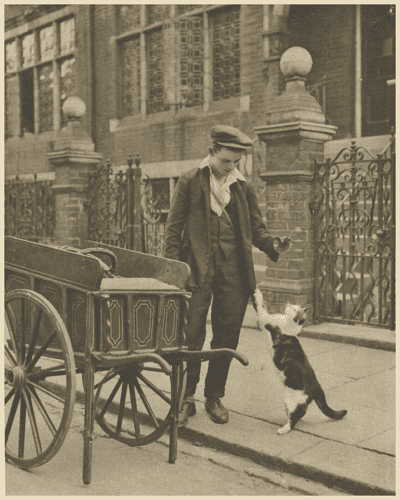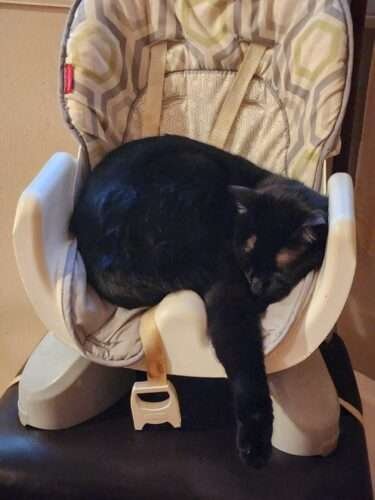The Cat’s Meat Man
In honor of National Black Cat Day, let’s take a peek at how Victorian cats got fed!
How Victorian Cats got fed

An article from the weekly paper ‘Chatterbox’, 1868, by W. Baird:
IT is calculated that there are somewhere about 300,000 cats in London. This rough calculation was made some years ago, allowing a cat to every inhabited house—an allowance which is under the mark, for it takes no account of what may be called the ‘ itinerant cats,’ who have no settled abode, but trust to casual hospitality. However, it is better to err on the safe side, and understate rather than overstate the case. Supposing, therefore, that there are only 300,000 cats in London, it is clear that even this modest number must be supplied with food. …
Hence the demand for cats’ meat has created a supply, and the vending of food for the cats and dogs is a regular branch of street trade. If we take a walk in the morning in some quiet neighbourhood, we shall very likely meet with an elderly gentleman in a shiny hat, and black plush waistcoat, with his shirt-sleeves tucked up above the arm, his body tightly girt with a coarse blue apron, and a multitude of neckerchiefs encircling his bull-like neck.
He wheels in front of him a small barrow very much like an ordinary gardener’s wheelbarrow. This is filled with meat, part of which is cut up into fragments and spitted upon wooden skewers, and part left uncut in a rough mass of coarse offal, which certainly does not look very inviting, at least to the human appetite. The cart is provided with a small ledge or shelf in front, on which the remainder of the meat can be cut up into slices at the pleasure of various customers.
This is a merchant who purveys for the wants of the cats and dogs of London. The meat in his little cart is not, as might be thought at first, the refuse of an ordinary market; it is meat which he specially provides, with a view to the palates of his customers. It is horse-flesh. The richer representatives of the trade buy it in large quantities from the ‘ knackers,’ who carry away horses which die in the streets…
As the cats’ meat man passes by the different houses, and announces his approach by a peculiar nasal yell, the cats may be seen furtively stealing up their respective areas, and eagerly seizing the meat which is thrown down to them. In large warehouses or breweries in the city, where numerous cats are kept, ‘ feeding-time’ is a scene almost worthy of the Zoological Gardens…
…casual customers pay for the meat as they get it, but it seems that people who deal in large quantities pay by the week, and look for the approach of the cats’-meat man with the same regularity as they would for the coming of the milk-man. So fond are our London cats of this meat, that after being long accustomed to it, they turn away with a well-bred disgust when anything else is offered to them as a substitute.


I have to say, I do prefer getting neatly canned or bagged cat food. The thought of raw meat, delivered in non-refrigerated carts is a bit off-putting. Apparently cat’s meat sellers were sometimes driven out of areas because the stench of their wares.
It’s not hard to imagine the local felines coming out to greet the ‘bringer of all good things’ while the cart trundles down the street. What do you bet that some cats had their favorite carts and sellers, too? Surely, Victorian cats were just as picky as ours today. Out little princess has very decided opinions about which cat food flavors are acceptable and which are only fit for her ‘I’ll eat anything’ brother.
References
https://historum.com/t/the-cats-meat-man-a-contemporary-account.37183/

Oh my, I’m sooo thrilled to have found your Random Bits of Fascination site!
I run a West Gallery Quire – singers and players looking at music of the people from 1760 – 1840ish. (sacred and secular)
I’m always on the look out for interesting “bits of random fascination” to enable us to learn about the life and times of village and town people in the West Gallery era.
Please could I have permission to quote some of your brilliant finds? We always credit and thank our contributors in a programme script.
We take our music and period snippets out to village halls and churches a couple of times each year.
We wear touches of period dress – hats, shawls etc.
We never charge a fee, but share our findings, as they are our passion and joy.
Every best wish and most high regards,
Caroline
I would be delighted to be quoted by your group. Thank you.
My fur babies eat Fancy Feast wet food and dry food. I really can’t see them eating horse flesh. I have tried other brands. They either threw it up or turned up their little noses.